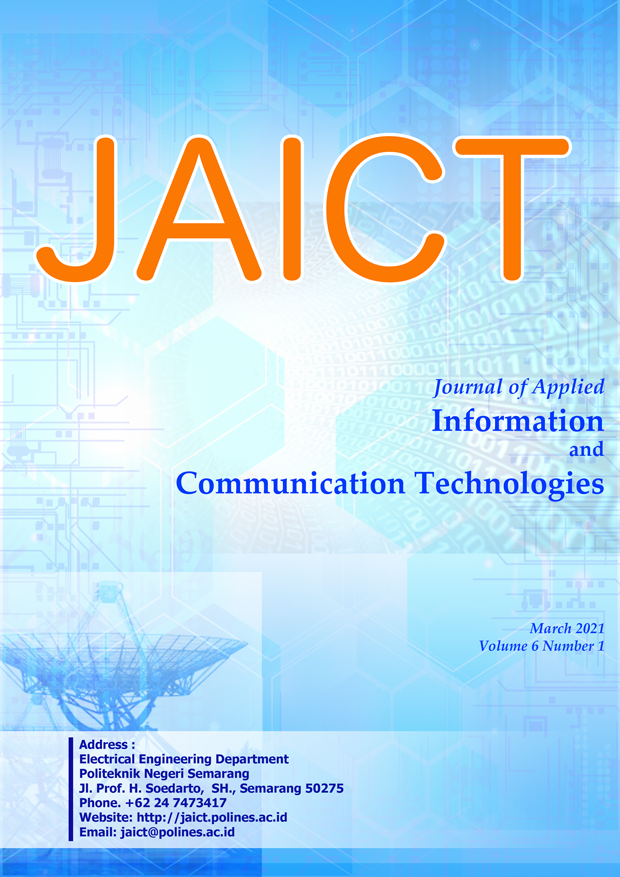Monitoring System Of Parking Land Availability And Number Of Cars In Web-Based Parking Place On The Smart Parking System
DOI:
https://doi.org/10.32497/jaict.v6i1.2058Keywords:
”” Smart Parking, IoT, monitoring system, web, propagation timeAbstract
According to data obtained from the website www.bps.go.id, the total number of motorized vehicles in Indonesia in 2018 was 146,858,759. The result of the increase in the number of motorized vehicles is that it is increasingly difficult to find parking space. People also often experience difficulties when finding which parking lot is still empty because there is no information about the state of the parking lot. Based on these problems, people need a system to check the parking lots available by utilizing the Internet of Things (IoT). Smart Parking Monitoring System is a web-based parking monitoring system that displays real-time parking availability information. The data was collected by simulating parking the car in the parking lot. Monitoring data transmission from the sensor node to the server is done using Wireshark software. The test results of the propagation time that occur in the data transmission process for an interval of 1 minute 15 seconds and the 5-second data transmission interval are 5053 milliseconds. The average value of the propagation time that occurs in the process of receiving data from the server is 197 milliseconds.References
R. Hafid Hardyanto, “Konsep Internet Of Things Pada Pembelajaran Berbasis Web,” J. Din. Inform., vol. 6, no. 1, pp. 87”“97, 2017.
M. I. Mahali, “SMART DOOR LOCKS BASED ON INTERNET of THINGS CONCEPT WITH MOBILE BACKEND as a SERVICE,” vol. 1, no. November, pp. 171”“181, 2016.
“Badan Pusat Statistik.” [Online]. Available: https://www.bps.go.id/linkTableDinamis/view/id/1133. [Accessed: 16-Nov-2020].
F. A. IMBIRI, N. TARYANA, and D. NATALIANA, “Implementasi Sistem Perparkiran Otomatis dengan Menentukan Posisi Parkir Berbasis RFId,” ELKOMIKA J. Tek. Energi Elektr. Tek. Telekomun. Tek. Elektron., vol. 4, no. 1, p. 31, 2018.
D. A. Limantara, Y. Cahyo, and S. W. Mudjanarko, “Pemodelan Sistem Pelacakan LOT Parkir Kosong Berbasis Sensor Ultrasonic Dan Internet Of Things ( IOT ) Pada Lahan Parkir Diluar Jalan,” Semin. Nas. Sains dan Teknol., vol. 1, no. 2, pp. 1”“10, 2017.
A. Tidake, N. Doijad, P. Yelbhar, S. Koul, and P. Murkute, “The Smart Car Parking System Based on Iot Commanded by Android Application,” IJSRD - Int. J. Sci. Res. Dev. Vol. 4, Issue 02, 2016, vol. 4, no. 02, pp. 1649”“1652, 2016.
G. Y. Saputra, A. D. Afrizal, F. K. R. Mahfud, F. A. Pribadi, and F. J. Pamungkas, “Penerapan Protokol MQTT Pada Teknologi Wan (Studi Kasus Sistem Parkir Univeristas Brawijaya),” Inform. Mulawarman J. Ilm. Ilmu Komput., vol. 12, no. 2, p. 69, 2017.
“Qwords.” [Online]. Available: https://qwords.com/blog/apa-itu-latency/. [Accessed: 12-Nov-2020].
M. Zia, “Penerapan Sistem Informasi Berbasis Web untuk Mendukung Pengelolaan Administrasi di Promusic Recording Studio Jepara,” Siadin.Dinus.Ac.Id, pp. 1”“10, 2014.
Downloads
Additional Files
Published
Issue
Section
License
Authors who publish with this journal agree to the following terms:Authors retain copyright and grant the journal right of first publication with the work simultaneously licensed under a Creative Commons Attribution License that allows others to share the work with an acknowledgement of the work's authorship and initial publication in this journal.
Authors are able to enter into separate, additional contractual arrangements for the non-exclusive distribution of the journal's published version of the work (e.g., post it to an institutional repository or publish it in a book), with an acknowledgement of its initial publication in this journal.
Authors are permitted and encouraged to post their work online (e.g., in institutional repositories or on their website) prior to and during the submission process, as it can lead to productive exchanges, as well as earlier and greater citation of published work (See The Effect of Open Access).






